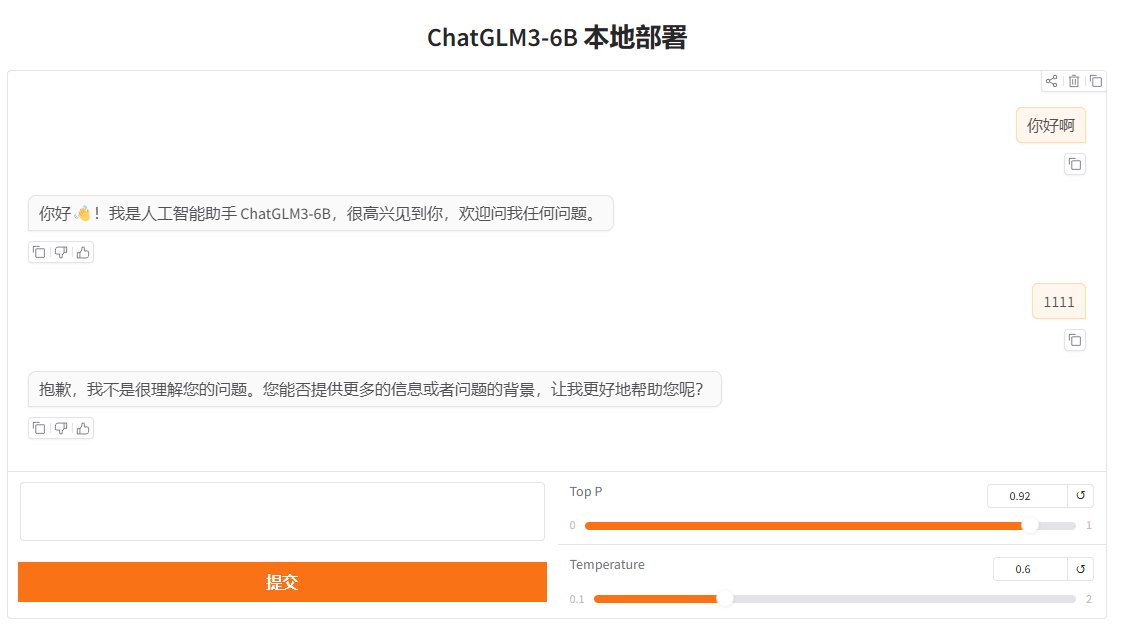ChatGLM3-6B 是一个 ChatGLM 系列的开源对话模型,是由清华大学 KEG 实验室和智谱 AI 共同开发。该模型具备出色的中文和英文理解和生成能力,特别适合多轮对话、文本生成、问答等自然语言处理任务。
模型下载:① https://huggingface.co/THUDM/chatglm3-6b ② https://hf-mirror.com/THUDM/chatglm3-6b ③ https://modelscope.cn/models/ZhipuAI/chatglm3-6b/
使用示例:https://github.com/THUDM/ChatGLM3
技术文档:https://zhipu-ai.feishu.cn/wiki/WvQbwIJ9tiPAxGk8ywDck6yfnof
下面我们在本地部署该模型(Windows 11 系统),实现如下效果:

1. 环境准备
官方给出的硬件要求如下:
- Int4 ChatGLM3-6B:
- 内存:8GB及以上
- 显存:5GB及以上
- FP16 ChatGLM3-6B:
- 内存:16GB及以上
- 显存:12GB及以上
创建虚拟环境 ChatGLM-env, 注意:Python 版本要求 3.10 以上。
conda create --name ChatGLM-env python=3.10
本地运行模型推理需要的依赖包(安装的 PyTorch 依赖,我这里下载的是支持 GPU 的版本):
pip install gradio==5.1.0 -i https://pypi.tuna.tsinghua.edu.cn/simple/ pip install transformers==4.40.0 -i https://pypi.tuna.tsinghua.edu.cn/simple/ pip install torch --index-url https://download.pytorch.org/whl/cu121 pip install sentencepiece -i https://pypi.tuna.tsinghua.edu.cn/simple/ pip install cpm_kernels -i https://pypi.tuna.tsinghua.edu.cn/simple/
2. 模型交互
我们使用 transformers 加载模型时,可以根据自己硬件情况加载不同的版本:
# FP16 ChatGLM3-6B estimator = AutoModel.from_pretrained(estimator_path, trust_remote_code=True).to(device) # Int4 ChatGLM3-6B estimator = AutoModel.from_pretrained(estimator_path, trust_remote_code=True).quantize(4).to(device)
完整的代码如下(可直接拷贝运行):
from transformers import AutoModel
from transformers import AutoTokenizer
import gradio as gr
import torch
import warnings
warnings.filterwarnings('ignore')
# torch.manual_seed(0)
device = 'cuda' if torch.cuda.is_available() else 'cpu'
# 加载分词器和模型
estimator_path = 'ChatGLM3-6B'
# FP16 ChatGLM3-6B
# estimator = AutoModel.from_pretrained(estimator_path, trust_remote_code=True).to(device).eval()
# Int4 ChatGLM3-6B
estimator = AutoModel.from_pretrained(estimator_path, trust_remote_code=True).quantize(4).to(device).eval()
tokenizer = AutoTokenizer.from_pretrained(estimator_path, trust_remote_code=True)
def predict(chatbot, top_p, temperature):
# 获得当前输入
message = chatbot[-1]['content']
# 获得以前输入
history = chatbot[:-1]
# 增加空回复
chatbot.append({'role': 'assistant', 'content': ''})
# 补充空回复
# 1. 迭代输出
for response, history in estimator.stream_chat(tokenizer,
query=message,
history=history,
# 用于产生多样性的文本的参数
top_p=top_p,
temperature=temperature):
# response 可能是 str 或者 dict 类型
# 如果是 dict 类型,需要取出其 content 值
print(response)
if isinstance(response, dict):
response = response['content']
chatbot[-1]['content'] = response
yield chatbot
# 2. 直接输出
# response, history = estimator.chat(tokenizer, query=message, history=history)
# if isinstance(response, dict):
# response = response['content']
# chatbot[-1]['content'] = response
# return chatbot
def user(message, chatbot):
return '', chatbot + [{'role': 'user', 'content': message}]
def vote(data: gr.LikeData):
if data.liked:
print('喜:', data.value, data.index)
else:
print('踩:', data.value, data.index)
def main():
css = '.group{max-width:1100px; margin:0 auto;}.bg{background-color:white;}.btn{padding:10px;background-color:white;}}'
with gr.Blocks(css=css, title='本地部署 ChatGLM3-6B 语言模型') as app:
gr.HTML('<center><h1>ChatGLM3-6B 本地部署</h1></center>')
with gr.Group(elem_classes='group'):
chatbot = gr.Chatbot(show_label=False,
type='messages',
show_copy_button=True,
show_share_button=True,
show_copy_all_button=True)
chatbot.like(fn=vote, inputs=None, outputs=None)
with gr.Row(elem_classes='bg'):
with gr.Column():
textbox = gr.Textbox(show_label=False, lines=2)
with gr.Group(elem_classes='btn'):
start = gr.Button('提交', variant='primary')
with gr.Column():
top_p = gr.Slider(0, 1, value=0.8, step=0.01, label="Top P", interactive=True)
temperature = gr.Slider(0.1, 2, value=0.6, step=0.1, label="Temperature", interactive=True)
start.click(user,
inputs=[textbox, chatbot],
outputs=[textbox, chatbot]).then(predict,
inputs=[chatbot, top_p, temperature],
outputs=chatbot)
app.launch(share=False, inbrowser=True)
if __name__ == '__main__':
main()
这里需要注意的是,运行 Int4 ChatGLM3-6B 时,可能如下报错:
Symbol cudaLaunchKernel not found in C:\Program Files (x86)\NVIDIA Corporation\PhysX\Common\cudart64_65.dll RuntimeError: Library cublasLt is not initialized
可以尝试去安装较新版本的 cuda toolkit https://developer.nvidia.com/cuda-toolkit 来解决。



 冀公网安备13050302001966号
冀公网安备13050302001966号
谢谢您,很有价值